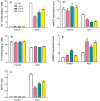A Medicago truncatula EF-hand family gene, MtCaMP1, is involved in drought and salt stress tolerance
- PMID: 23593126
- PMCID: PMC3620156
- DOI: 10.1371/journal.pone.0058952
A Medicago truncatula EF-hand family gene, MtCaMP1, is involved in drought and salt stress tolerance
Abstract
Background: Calcium-binding proteins that contain EF-hand motifs have been reported to play important roles in transduction of signals associated with biotic and abiotic stresses. To functionally characterize genes of EF-hand family in response to abiotic stress, an MtCaMP1 gene belonging to EF-hand family from legume model plant Medicago truncatula was isolated and its function in response to drought and salt stress was investigated by expressing MtCaMP1 in Arabidopsis.
Methodology/principal findings: Transgenic Arabidopsis seedlings expressing MtCaMP1 exhibited higher survival rate than wild-type seedlings under drought and salt stress, suggesting that expression of MtCaMP1 confers tolerance of Arabidopsis to drought and salt stress. The transgenic plants accumulated greater amounts of Pro due to up-regulation of P5CS1 and down-regulation of ProDH than wild-type plants under drought stress. There was a less accumulation of Na(+) in the transgenic plants than in WT plants due to reduced up-regulation of AtHKT1 and enhanced regulation of AtNHX1 in the transgenic plants compared to WT plants under salt stress. There was a reduced accumulation of H2O2 and malondialdehyde in the transgenic plants than in WT plants under both drought and salt stress.
Conclusions/significance: The expression of MtCaMP1 in Arabidopsis enhanced tolerance of the transgenic plants to drought and salt stress by effective osmo-regulation due to greater accumulation of Pro and by minimizing toxic Na(+) accumulation, respectively. The enhanced accumulation of Pro and reduced accumulation of Na(+) under drought and salt stress would protect plants from water default and Na(+) toxicity, and alleviate the associated oxidative stress. These findings demonstrate that MtCaMP1 encodes a stress-responsive EF-hand protein that plays a regulatory role in response of plants to drought and salt stress.
Conflict of interest statement
Figures









Similar articles
-
Physiological mechanisms underlying OsNAC5-dependent tolerance of rice plants to abiotic stress.Planta. 2011 Aug;234(2):331-45. doi: 10.1007/s00425-011-1403-2. Epub 2011 Mar 30. Planta. 2011. PMID: 21448719
-
Expression of a Medicago falcata small GTPase gene, MfARL1 enhanced tolerance to salt stress in Arabidopsis thaliana.Plant Physiol Biochem. 2013 Feb;63:227-35. doi: 10.1016/j.plaphy.2012.12.004. Epub 2012 Dec 26. Plant Physiol Biochem. 2013. PMID: 23298681
-
Wheat TaTIP4;1 Confers Enhanced Tolerance to Drought, Salt and Osmotic Stress in Arabidopsis and Rice.Int J Mol Sci. 2022 Feb 14;23(4):2085. doi: 10.3390/ijms23042085. Int J Mol Sci. 2022. PMID: 35216200 Free PMC article.
-
Function in disorder: A review on the roles of the disordered dehydrin proteins in conferring stress tolerance.Int J Biol Macromol. 2025 Jun;311(Pt 2):143672. doi: 10.1016/j.ijbiomac.2025.143672. Epub 2025 Apr 30. Int J Biol Macromol. 2025. PMID: 40316120 Review.
-
Osmotin: a plant sentinel and a possible agonist of mammalian adiponectin.Front Plant Sci. 2015 Mar 16;6:163. doi: 10.3389/fpls.2015.00163. eCollection 2015. Front Plant Sci. 2015. PMID: 25852715 Free PMC article. Review.
Cited by
-
Rehydration Compensation of Winter Wheat Is Mediated by Hormone Metabolism and De-Peroxidative Activities Under Field Conditions.Front Plant Sci. 2022 Feb 24;13:823846. doi: 10.3389/fpls.2022.823846. eCollection 2022. Front Plant Sci. 2022. PMID: 35283926 Free PMC article.
-
A novel α/β-hydrolase gene IbMas enhances salt tolerance in transgenic sweetpotato.PLoS One. 2014 Dec 12;9(12):e115128. doi: 10.1371/journal.pone.0115128. eCollection 2014. PLoS One. 2014. PMID: 25501819 Free PMC article.
-
Transcriptome Analysis for Salt-Responsive Genes in Two Different Alfalfa (Medicago sativa L.) Cultivars and Functional Analysis of MsHPCA1.Plants (Basel). 2024 Apr 11;13(8):1073. doi: 10.3390/plants13081073. Plants (Basel). 2024. PMID: 38674482 Free PMC article.
-
ZmCaM2-1, a Calmodulin Gene, Negatively Regulates Drought Tolerance in Transgenic Arabidopsis Through the ABA-Independent Pathway.Int J Mol Sci. 2025 Feb 27;26(5):2156. doi: 10.3390/ijms26052156. Int J Mol Sci. 2025. PMID: 40076781 Free PMC article.
-
Transcriptome Analysis of Spartina pectinata in Response to Freezing Stress.PLoS One. 2016 Mar 31;11(3):e0152294. doi: 10.1371/journal.pone.0152294. eCollection 2016. PLoS One. 2016. PMID: 27032112 Free PMC article.
References
-
- Bush DS (1995) Calcium regulation in plant cells and its role in signaling. In: Jones RL, editor. Annual Review of Plant Physiology and Plant Molecular Biology. 95–122.
-
- Tuteja N (2007) Mechanisms of high salinity tolerance in plants. Methods Enzymol 428: 419–438. - PubMed
-
- Takano M, Takahashi H, Suge H (1997) Calcium requirement for the induction of hydrotropism and enhancement of calcium-induced curvature by water stress in primary roots of pea, Pisum sativum L. Plant Cell Physiol. 38: 385–391.
-
- Knight H (2000) Calcium signaling during abiotic stress in plants. Int Rev Cytol 195: 269–324. - PubMed
Publication types
MeSH terms
Substances
LinkOut - more resources
Full Text Sources
Other Literature Sources
Molecular Biology Databases

